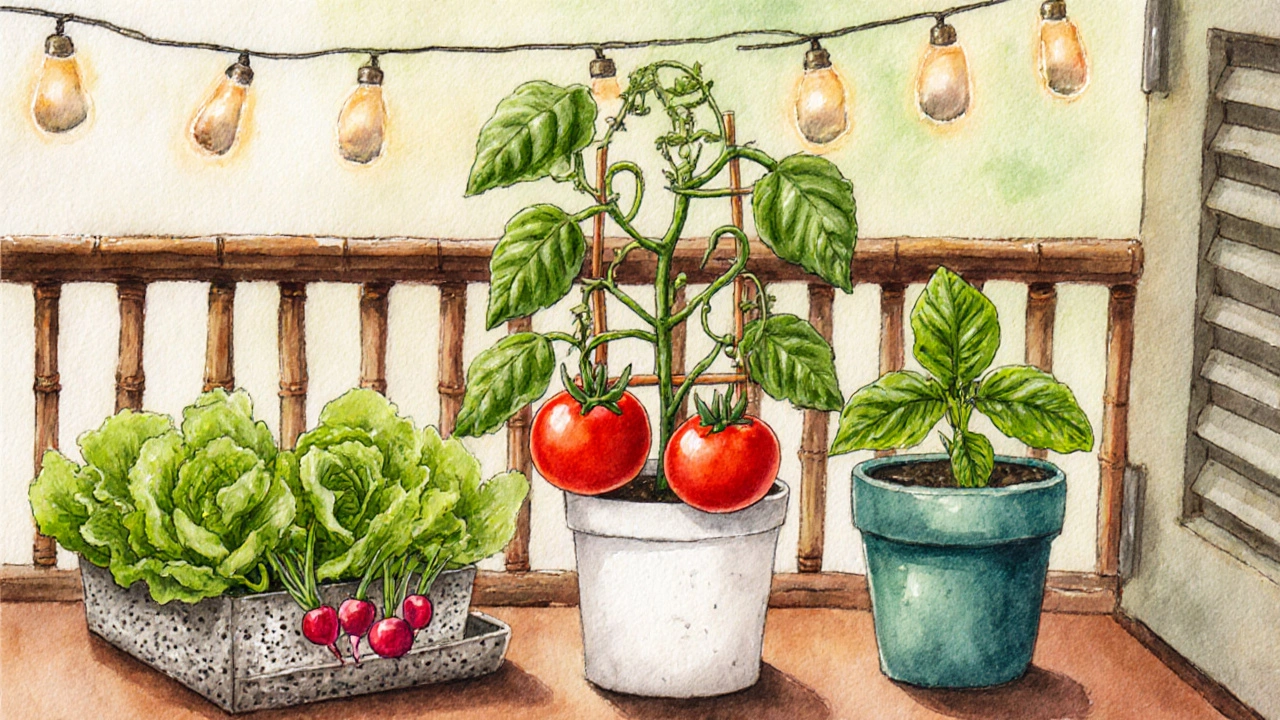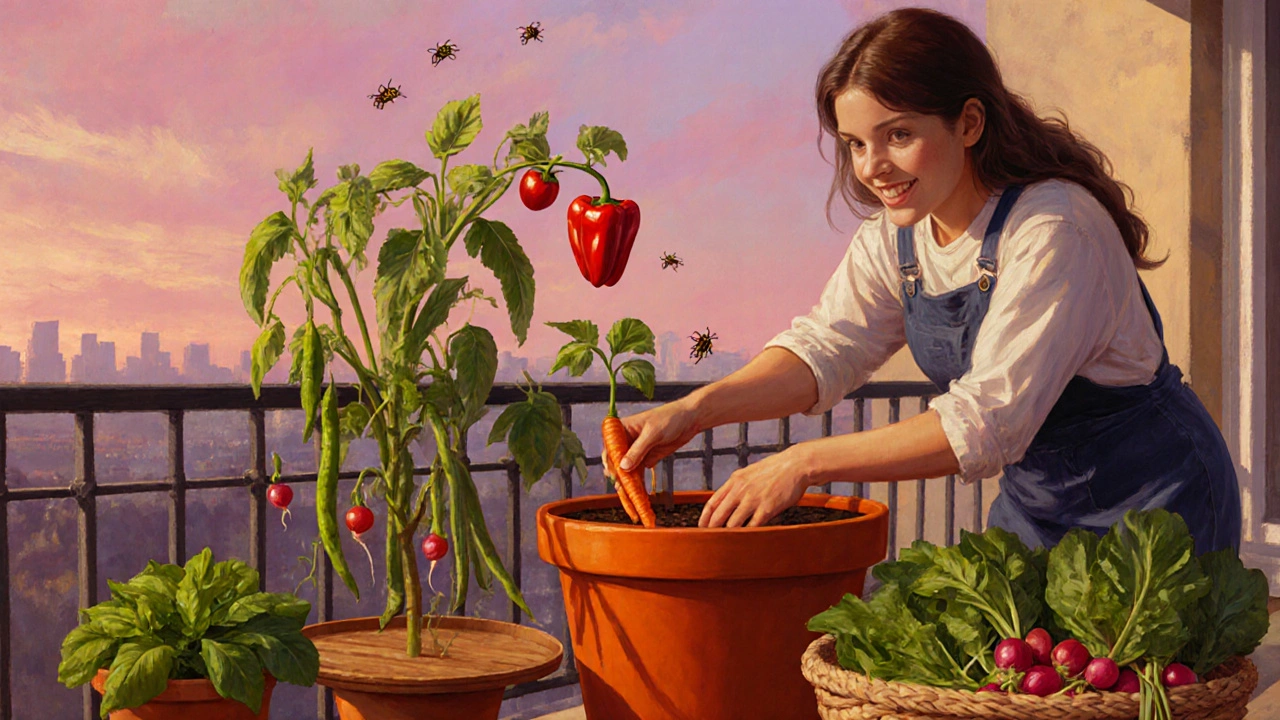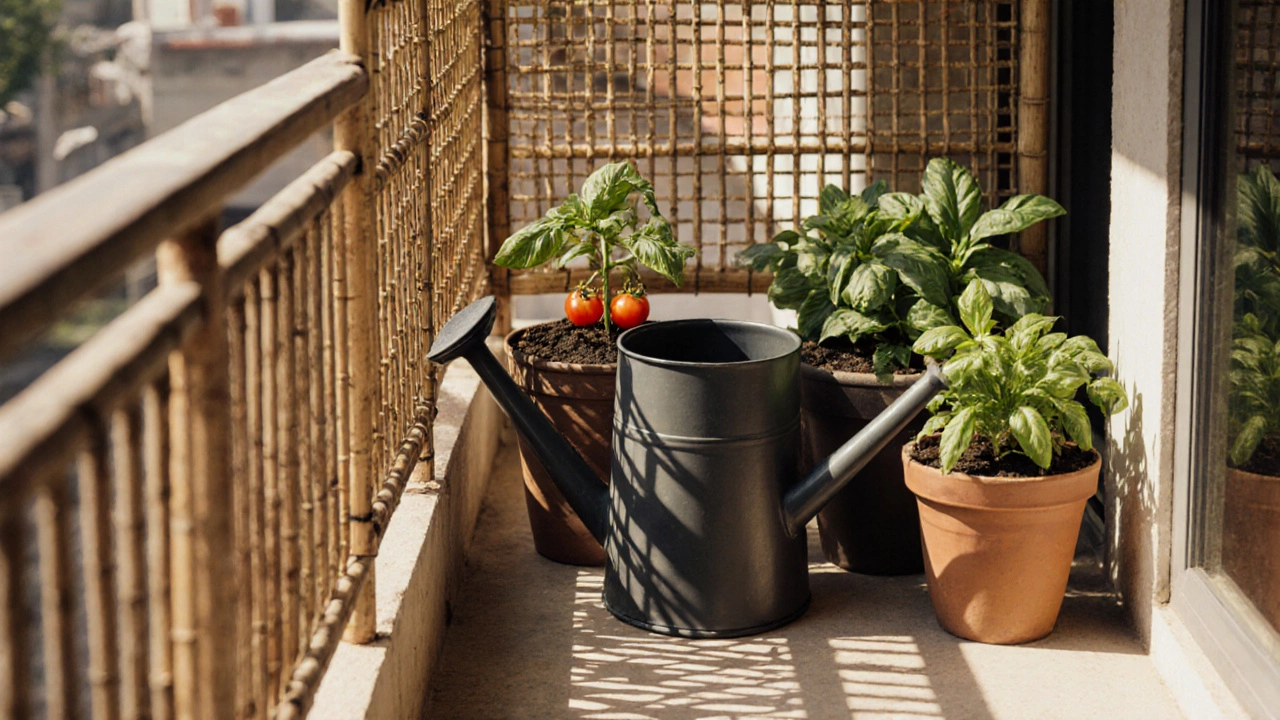Balcony Garden Planner
☀️ Your Balcony Conditions
How It Works
Answer a few questions about your balcony conditions, and we'll recommend the best vegetables for your space.
Select the option that best matches your balcony, then click "Get Recommendations" to see which vegetables will thrive in your space.
Your Recommended Vegetables
Balcony vegetable gardening is a type of urban gardening that lets you grow fresh produce on limited outdoor spaces. Whether you have a sunny rail or a shaded nook, the right plant choices turn a cramped balcony into a mini‑farm. This guide breaks down the most reliable vegetables, how to match them to your light and wind conditions, and practical tips to keep harvests coming year after year.
Key Takeaways
- Sun‑loving veggies like tomatoes and peppers thrive in South‑facing balconies with at least 6hours of direct light.
- Cool‑season crops such as lettuce, spinach, and radishes are perfect for early spring or autumn when the sun is gentler.
- Choose compact or dwarf varieties, and use deep containers (12‑18inches) for root‑heavy plants like carrots.
- Regular watering, lightweight potting mix, and occasional feeding keep plants productive on limited soil.
- Rotate crops and recycle containers to avoid soil‑borne diseases and make the most of your space.
1. Assess Your Balcony Conditions
Before you buy any seed packets, spend a week watching the space. Note how many hours of direct sunlight each spot receives, whether wind gusts blow across the railing, and how much weight the balcony can safely support. Most vegetables need at least 4‑6hours of bright, direct sun; shade‑tolerant greens can manage with 3‑4hours.
Use a simple checklist:
- Sunlight: South‑ or West‑facing is ideal.
- Wind: If it feels breezy, add a windbreak like a bamboo screen or lattice.
- Weight limit: Plan for containers that won’t exceed the deck’s rating - typically 30‑40kg per square foot for residential balconies.
- Water access: Proximity to a tap or rain barrel makes regular watering easier.
2. Top Vegetable Picks for Small Spaces
Below are the most dependable choices, each described with a brief microdata definition. These varieties have been proven to perform well in containers and limited root volume.
Tomato is a warm‑season fruit (often treated as a vegetable) that produces juicy berries on vines. Dwarf or determinate types like ‘Patio’, ‘Tiny Tim’, or ‘Tumbling’ stay compact, making them perfect for pots or hanging baskets. A single healthy plant can yield 5‑10lb of fruit over the season.
Plant in a 12‑inch deep pot with a strong support stake. Use a high‑phosphate fertilizer once a month to encourage fruit set.
Lettuce is a fast‑growing leafy green that prefers cool temperatures and shallow soil. Loose‑leaf varieties such as ‘Buttercrunch’ and ‘Red Sails’ can be harvested cut‑and‑come‑again, extending the harvest window. You can start a new sow every two weeks for a continuous supply.
Use a shallow tray (6‑8inches) and keep the soil consistently moist. Shade the tray in midsummer to prevent bolting.
Spinach is a cool‑season leafy vegetable that tolerates partial shade. Varieties like ‘Baby’s Leaf’ and ‘Space’ grow quickly and can be harvested in 30‑45days. Spinach yields multiple cuttings before the plant bolts.
Plant in a 6‑inch deep container; add a layer of mulch to retain moisture.
Radish is a root vegetable that matures in as little as 20days, making it a favorite for quick balcony harvests. ‘Cherry Belle’ and ‘White Icicle’ are compact and tolerate a range of soils. A single sow can produce dozens of radishes per container.
Sow seeds ½inch deep in a 10‑inch pot and keep the soil lightly moist.
Basil is an aromatic herb that loves warmth and well‑drained soil. Dwarf types like ‘Greek’ stay under 12inches tall, perfect for a sunny windowsill or balcony rail. Regular pinching encourages bushier growth and more leaves.
Plant in a 6‑inch pot, water when the top inch of soil feels dry, and fertilise lightly every 4‑6weeks.
Peppers (both sweet and hot) are compact plants that thrive in warm, sunny spots. ‘Mini Bell’ and ‘Jalapeño’ varieties stay under 18inches tall, ideal for balcony pots. A single plant can produce dozens of peppers over a long season.
Use a 10‑inch deep container with a balanced fertilizer; avoid over‑watering to prevent root rot.
Green beans are vining legumes that climb trellises. Dwarf bush types like ‘Provider’ don’t need support and fit neatly in 12‑inch pots. They fix nitrogen in the soil, improving fertility for later crops.
Plant 3‑4 seeds per pot, keep soil evenly moist, and harvest beans when pods are 4‑5cm long.
Carrots are root crops that need deeper containers (12‑18inches) to develop straight, sweet roots. ‘Thumbelina’ and ‘Paris Market’ are short‑rooted varieties designed for containers. Carrots can be harvested anywhere from 60‑80days after sowing.
Use a lightweight, sandy potting mix; keep the soil consistently moist to avoid split roots.

3. Comparison Table: Sunlight, Water, and Harvest Time
| Vegetable | Sunlight (hrs/day) | Water Needs | Typical Harvest (days) |
|---|---|---|---|
| Tomato (dwarf) | 6‑8 | Medium‑high | 70‑85 |
| Lettuce (leaf) | 4‑6 | Medium | 30‑45 |
| Spinach | 3‑5 | Medium | 35‑45 |
| Radish | 4‑6 | Low‑medium | 20‑30 |
| Basil | 5‑7 | Medium | 45‑60 |
| Peppers (mini) | 6‑8 | Medium | 60‑80 |
| Green beans (bush) | 5‑7 | Medium | 55‑70 |
| Carrots (short‑root) | 4‑6 | Low‑medium | 70‑90 |
4. Soil, Fertiliser and Watering Basics
Container gardening limits the soil volume, so a quality potting mix is essential. A good blend contains peat or coconut coir (for moisture retention), perlite or vermiculite (for aeration), and a modest amount of compost (for nutrients). Avoid garden soil - it compacts quickly and can harbor pests.
Fertiliser tips:
- Use a balanced 10‑10‑10 water‑soluble fertilizer every 2‑3weeks for fast growers like tomatoes and peppers.
- For leafy greens (lettuce, spinach, basil), choose a higher nitrogen formula (e.g., 20‑10‑10) to boost leaf production.
- Apply a slow‑release granular fertilizer once at planting for root crops like carrots.
Watering is the trickiest part. Containers dry out 2‑3times faster than ground beds. Check the top inch of soil each morning - if it feels dry, water until you see water trickle from the drainage holes. Early‑morning watering reduces evaporation and helps prevent fungal diseases.
5. Seasonal Planting Calendar for UK Balconies
Britain’s climate is mild, but you still need to respect frost dates. Below is a simple timeline that works for most cities, including Manchester.
- February-March: Start seeds indoors for tomatoes, peppers, and basil. Use seed‑starting trays on a sunny windowsill.
- April: Transplant hardened‑off seedlings to the balcony once night lows stay above 5°C. Direct‑sow lettuce, spinach, and radishes.
- May-June: Full summer planting - all warm‑season veg can be sown. Keep an eye on watering during dry spells.
- July-August: Harvest early crops, sow a second round of quick growers (radish, lettuce) for autumn.
- September: Begin cool‑season crops again (spinach, lettuce) as days shorten.
- October-November: Harvest remaining warm‑season veg, protect tender plants with fleece if frost threatens.
Because balconies are micro‑climates, you can often extend the growing season with a simple portable greenhouse or row cover.

6. Troubleshooting Common Balcony Issues
Yellowing leaves usually mean nutrient deficiency or over‑watering. Check the soil’s moisture level and consider a light nitrogen boost.
Leggy stems indicate insufficient light. Move the pot to a brighter spot or add a reflective surface to bounce sunlight.
Powdery mildew appears as a white dust on leaves, often after a humid night. Increase air circulation, water at the base, and spray a mild neem oil solution.
Root rot shows black, mushy roots and wilting despite wet soil. The cure is to repot with fresh, well‑draining mix and reduce watering frequency.
7. Bonus: Using Companion Planting on a Balcony
Space is precious, so pair compatible plants to maximise yield. For example, plant basil alongside tomatoes - basil repels tomato hornworms and improves flavor. Intercrop radishes with lettuce; radish roots break up soil, making it easier for lettuce to grow. Even a small trellis can support green beans, freeing up floor space for leafy greens.
8. Next Steps
Pick two or three vegetables from the list that match your balcony’s light and wind profile. Purchase the appropriate containers, potting mix, and starter seeds this weekend. Follow the planting dates above, and within a month you’ll be harvesting fresh, home‑grown produce right from your balcony.
Frequently Asked Questions
Can I grow potatoes on a balcony?
Yes, but choose a compact variety like ‘Irish Cobbler’ and plant in a deep (12‑inch) container. Harvest when the foliage dies back, usually 80‑100days after planting.
How often should I fertilise my balcony vegetables?
For fast‑growing crops (tomatoes, peppers) use a balanced liquid fertilizer every 2‑3weeks. Leafy greens benefit from a higher‑nitrogen feed, also applied every 2‑3weeks. Slow‑release granules can be added once at planting for root crops.
What’s the best way to protect plants from strong balcony winds?
Create a wind break using a trellis, bamboo screen, or even a tall potted shrub placed upwind. You can also wrap pots in burlap or use heavier containers that don’t tip over.
Do I need to water daily in summer?
Not necessarily daily - it depends on heat, wind, and container size. Check the top inch of soil; if it feels dry, water thoroughly until it drains. Early morning watering is most efficient.
Can I grow fruit trees on a balcony?
Dwarf varieties such as ‘Bonaparte’ lemon or ‘Meyer’ cherry can survive in large pots (at least 20‑gallon). They need full sun, regular feeding, and winter protection in the UK.

